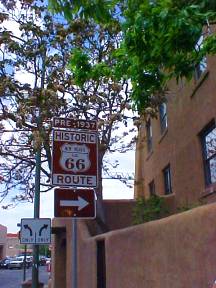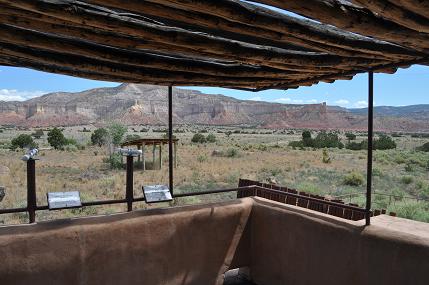If you hop off I-40 from Albuquerque to make the “Santa Fe Loop” you are technically still on Route 66. Pre-1937 the Mother Road followed the Old Pecos Trail to New Mexico’s capital, Santa Fe, a fact that was celebrated by the town. To Santa Fe’s detriment, a governor lost his bid for re-election and blamed his loss on the politicians of that town. With revenge in his heart, he spent his last months in office working at fast pace to re-align Route 66 so that it would by-pass Santa Fe altogether. It is said that his motive was purely sour grapes, but in the end the new Route was more direct and cut miles off the original route.
 As a result there are few Route 66 signs in Santa Fe. A few exist along the old Route and they clearly state: Pre-1937 Route 66. Along Cerrillos Avenue we passed many old motels left over from the days Route 66 flourished, many still in business. The El Rey Motel has been modernized but close by The King’s Court, open for business, features car ports next to the rooms and looks much like it did at its peak.
As a result there are few Route 66 signs in Santa Fe. A few exist along the old Route and they clearly state: Pre-1937 Route 66. Along Cerrillos Avenue we passed many old motels left over from the days Route 66 flourished, many still in business. The El Rey Motel has been modernized but close by The King’s Court, open for business, features car ports next to the rooms and looks much like it did at its peak.
Day trips from Santa Fe included Los Alamos, Bandalier, Abuquiu, Ghost Ranch, Georgia O’Keeffe’s home and Taos Pueblo. Read on.
LOS ALAMOS: HOME OF FAT MAN AND LITTLE BOY
About an hour’s drive from Santa Fe is Los Alamos, the land of scientific discovery. The Bradbury Science Museum offers exhibits and movies, mostly about
the development of the atomic bomb. During World War II scientists were attempting to build the bomb from points throughout the U.S. It was decided to pool all of the resources and personnel into one area to be more efficient. Los Alamos was selected for many reasons. This was all done in great secrecy. Residents were moved out and laboratories were built. We all know what happened in the end. Today scientists are charged with “stewardship,” meaning that they are to make sure that if an atomic bomb is ever needed again, that it will work despite the effects of aging. This is a hefty bill because actual testing is not allowed.
BANDALIER NATIONAL MONUMENT
In contrast to the computers and scientific equipment of nearby Los Alamos, is the cliff dwellings of the Ancestral Pueblo People.
I was taught to call them the Anasazi but was told recently that term is offensive. I don’t know who could be offended because these people disappeared before the pueblo Indians inhabited the area.
However, the park is lovely and a pleasant 1.5 mile hike leads you along a river, through the trees to the cliffs where dwellings date back to 1150 A.D. There are winding trails and stairs to the dwellings, some with ladders that allow you to actually go in and look around. There are kivas, rock paintings and petroglyphs. This was one of the highlights of our trip thus far.
ABUQUIU, GHOST RANCH AND GEORGIA O’KEEFE
An hour’s drive from Santa Fe near the town of Espanola, is the little town of Abiquiu which mostly consists of the Inn and a mercantile. We were there to tour the home of the famed artist Georgia O’Keeffe. After living in New York, O’Keeffe finally took up residence in Abiquiu, having visited there many years before and not able to forget its beauty. Walking around Ghost Ranch where she had a home, it is easy to see how she became inspired to paint the colorful mesas which surround the area.
the famed artist Georgia O’Keeffe. After living in New York, O’Keeffe finally took up residence in Abiquiu, having visited there many years before and not able to forget its beauty. Walking around Ghost Ranch where she had a home, it is easy to see how she became inspired to paint the colorful mesas which surround the area.
Later she purchased a home in the little pueblo of Abiquiu. It is that home we were able to tour. We were fortunate to secure a reservation for that tour. They only run at certain times and are limited to groups of 12. We toured her garden, kitchen, and courtyard. Most impressive was her studio with its picture window. O’Keeffe died in 1986 at the age of 98 so some of the people we met had actually known her. After returning to Santa Fe, we visited the Georgia O’Keeffe Museum where her abstract work was on display. After touring the Ranch and her home, we appreciated her abstract work and could understand clearly what she was trying to convey. This to me was a real education because I had never really understood or appreciated abstract work before.
TAOS PUEBLO: A LIVING NATIVE AMERICAN COMMUNITY
About an hour’s drive of Abiquiu is Taos. It was a lovely drive, but once we got to Taos the traffic was horrendous and it took almost 45 minutes to get through the small town to the famed Pueblo. Just as we reached the Pueblo, the “closed” sign went up. We parked and Alan jumped out of the car and photographed what we could see from the street which was the cemetery. A security guard reprimanded him and told us to leave since the pueblo was closed, we didn’t have a photo permit and you probably aren’t supposed to take a picture of the cemetery at any rate! But it is a great shot!
South of Taos we were rewarded for our efforts. We found the Spanish Colonial San Francisco of Assisi Church. This adobe church has inspired travelers and artists alike, including O’Keeffe and Ansel Adams. It is a fortress-like adobe building with four-foot thick walls and graceful lines, most striking framed by the brilliant blue New Mexico sky. It is believed to have been built in 1850 and is an active Catholic Church for the Los Ranchos de Taos.
Next to the church Alan spotted this lovely typical pueblo door and snapped a photo.
